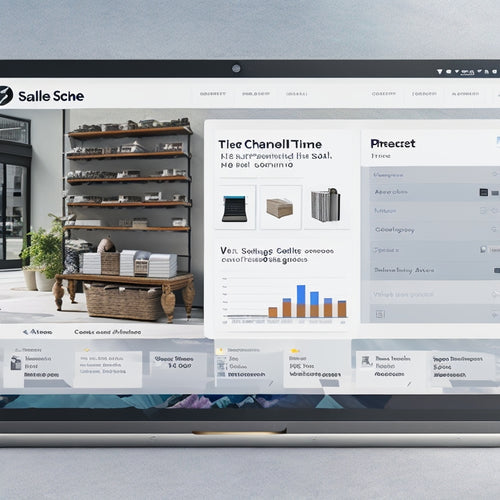
Unveiling Success: Beginner's Guide to Lucrative Dropshipping
Share
Harnessing the power of dropshipping necessitates a solid understanding of its fundamentals, including the change in inventory management and shipping responsibilities. Effective supplier selection is pivotal for maintaining profit margins, and a well-crafted online store is indispensable for showcasing products and providing a smooth customer experience. Additionally, identifying profitable products through comprehensive research and market trend analysis is crucial. By mastering these components, entrepreneurs can tap into the potential for profitable earnings. As you delve into the realm of dropshipping, you'll uncover the nuances of this business model and reveal the strategies to drive revenue and growth.
Key Takeaways
• Revolutionize your supply chain by shifting inventory management and shipping responsibilities to suppliers for increased efficiency.
• Effective supplier selection is crucial, as it directly impacts profit margins and ensures timely delivery, quality products, and competitive pricing.
• Establish a professional online storefront that showcases products effectively, with optimized website design and navigation for a seamless customer experience.
• Identify profitable products by conducting thorough research, analyzing market trends, and evaluating profit margins to capitalize on untapped markets.
• Focus on marketing and customer service by leveraging tools like Google Trends and Amazon Best Sellers to attract and retain customers.
Understanding Dropshipping Fundamentals
Operating based on the premise that products are sold without being held in inventory, dropshipping revolutionizes the traditional supply chain by transferring inventory management and shipping responsibilities from the retailer to the manufacturer or supplier. This paradigm shift allows retailers to focus on marketing strategies and customer service, while suppliers handle logistics.
Effective supplier selection is vital, as it directly impacts profit margins. A well-chosen supplier can guarantee timely delivery, quality products, and competitive pricing, ultimately leading to increased customer satisfaction and loyalty.
Setting Up Your Online Store
With a solid grasp of dropshipping basics in place, the next step is to establish a professional online storefront that effectively showcases products and provides a seamless customer experience.
This involves website optimization, ensuring easy navigation, and implementing marketing strategies to attract and retain customers.
A secure payment processing system is also essential, providing customers with a trustworthy and hassle-free transaction experience.
In addition, a robust customer service system must be in place to handle customer inquiries, returns, and refunds efficiently.
Finding Profitable Products
Identifying profitable products is an essential step in the dropshipping process, as it directly impacts your business's bottom line and long-term sustainability. To find lucrative products, conduct thorough product research, analyzing market trends and demand. Utilize online tools, such as Google Trends and Amazon Best Sellers, to identify popular products.
Evaluate profit margins by calculating the difference between the selling price and the cost of the product. Additionally, perform competition analysis to assess the number of sellers and their pricing strategies. By doing so, you can pinpoint opportunities to differentiate your business and capitalize on untapped markets.
Frequently Asked Questions
How Do I Handle Product Returns and Refunds in Dropshipping?
'Navigating the choppy waters of product returns and refunds in dropshipping requires a clear charted course. Establish a seamless return process and transparent refund policy to guarantee customer satisfaction, build trust, and minimize financial losses.'
What Are the Tax Implications of Running a Dropshipping Business?
When running a dropshipping business, understanding tax implications, including tax deductions on business expenses and potential international sales restrictions, is crucial to comply and reduce liabilities, while maximizing profit margins.
Can I Use Dropshipping With a Business Partner or Team?
'71% of entrepreneurs report that partnerships accelerate business growth. When dropshipping with a business partner or team, effective partner dynamics and team collaboration are pivotal, ensuring shared goals, defined roles, and open communication to mitigate risks and maximize profits.'
How Do I Protect My Business From Suppliers Who Don't Fulfill Orders?
To safeguard your business, prioritize supplier reliability by implementing robust monitoring systems to track order fulfillment. Develop contingency plans with alternative suppliers to mitigate risks, ensuring seamless delivery and maintaining customer trust.
Can I Use Dropshipping to Sell Products on Social Media Platforms?
"Can social media platforms be leveraged to catapult your dropshipping business to success? Absolutely! By implementing effective social media strategies and leveraging influencer partnerships, you can tap into a vast customer base and drive sales, all while ensuring a secure and reliable fulfillment process."
Related Posts
-

7 Best Digital Tools for Product Creation Success
You're likely no stranger to the frustrations of inefficient product creation processes, but with the right digital t...
-
Best Sitemap Generator App for Shopify to Improve Your SEO
This article explores the benefits and tips for optimizing SEO using a sitemap generator app specifically designed f...
-

What Can You Automate on Shopify
This article examines the potential for automation on the Shopify platform. It discusses the benefits of automation ...

